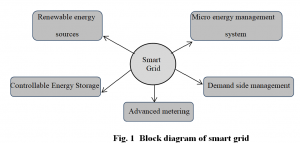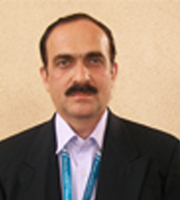Smart Grid and its Challenges:-
The growing consumer demand of electric energy every day and the aging transmission and distribution power grid infrastructure in India is causing new challenges for engineers. In recent years, domestic as well as industrial consumers are using more and more computers, servers, communication equipment, process control equipment, sophisticated machinery and power electronic equipment for automation purpose and to improve efficiency of various mechanical and chemical processes. Thiselectronic equipment is called as “sensitive load” (or critical load) because it does not tolerate any voltage fluctuations, voltage sags and power failures of electric supply. In short, the consumer these daysdemands high expectations of power quality from electrical power utilities. If the electrical power is not maintained within strict power quality specifications, this sensitive electronic load equipment may get damaged or may malfunction causing huge production loss and data loss to the consumers.
At the same time, it is not possible to discard huge investments made by Governments in various countries in terms of transmission and distribution grid infrastructure. Hence, the challenge is to make the existing power grid more efficient and reliable by minimizing voltage and frequency fluctuations, providing good power quality and improving grid stability. To reduce carbon emissions due to burning of fossil fuel, government is encouraging small to mid-size installations of renewable energy sources such as solar photovoltaic (PV) systems and wind power generation systems. The nature of these renewable energy sources is that they produce intermittent power generation based on solar and wind energy availability during the day and their high penetration in grids are posing problems of voltage and frequency instability. Due to distributed nature of energy sources, fast response to the user demand needs to be achieved in more efficient manner and it is also required to balance the demand and supply patterns more closely in order to avoid power outages and voltage fluctuations at user end.
Consumer demand increase on the electrical energy sources makes it necessary to have for more efficient power generation and distribution systems instead of only increasing the installed capacity. Hence, the existing power grid needs to be converted into a “smart grid” so as to make it more intelligent, self-healing, efficient and consumer friendly so thatconsumerscan get rebate in tariff if electricity is consumed during non-peak hours.
Smart grid is nothing but transformation of existing grid into futuristic power grid which incorporates smart metering devices, advanced control techniques and Information & Communication Technologies (ICT) at transmission and distribution levels in order to supply electricity in a more user-friendly way. Few important characteristics of smart grid are user friendliness, self-sustenance, robustness in terms of its ability to accommodate various generation and storage requirements and market driven efficient operation, high power quality and reduced energy storage capacity. Hence smart grid is essential for various environmental, political, socio-economic and technical factors. Key elements of a smart grid include renewable energy sources, controllable energy storage, micro-energy management system, demand side energy management system and advanced metering including smart metering devices as shown in Fig. 1 below.

Smart grid also incorporates demand side load management which allows customers to make selection of their energy consumption requirements during a day schedule and helps utility companies to reduce their peak load demand significantly. Demand side load management allows customers to make decisions regarding their energy consumption and helps the energy providers to reduce the peak load demand and reshape the load profile. It focusses on utilizing power saving technologies, electricity tariffs, monetary incentives and government policies to mitigate peak load demand instead of increasing the installed capacity. The shape of load demand curve is changed by reducing the total load demand during the peak hours by shifting the loads to be served during more appropriate timeof the day thereby reducing the overall operational cost.
Another technique of demand side load management is the use of electric spring technology. This technology can be used for providing good power quality by stabilizing voltage and power fluctuations caused due to renewable energy generation such as Photovoltaic (PV) and wind power sources. Electric spring essentially consists of power electronic inverter which dampens the voltage fluctuations caused by intermittent renewable generation by absorbing or injecting the reactive power and distributing it to the non-critical loads which areconnected in series with the electric spring. It ensures stable voltage and power to the sensitive electronic loads.Electric spring essentially converts the non-critical, wide voltage resistive load such as heating and lighting load to a “smart load” which follows the patterns of renewable power generation and the voltage at the critical load is maintained constant. It also improves the power factor and reduces the energy storage requirements of the grid.
Future Research:
Currently extensive research is going on in this emerging area of “smart grid” in terms of development of new algorithms to make the grid more efficient and secure. Confidentiality of data is very critical for reliable and smooth operation of smart grid. Also, large amount of data gets generated within the grid, hence data analysis and data mining techniques are used for processing the data efficiently and take smart / intelligent decisions regarding demand side load management by training the grid using fuzzy logic and artificial neural network techniques. Consumer load patterns can be analyzed and decisions can be taken regarding intelligent switching of the loads and/or use of electric spring technology so as to reduce the peak demand on the grid and energy storage requirements.
Prof. Ravindra Joshi
Associate Professor, Dept. of Engineering Sciences
International Institute of Information Technology (I2IT)
P-14 Rajiv Gandhi Infotech Park, Pune-411057
Email: ravindraj@isquareit.edu.in
Mobile: 9822021594



Recent Comments